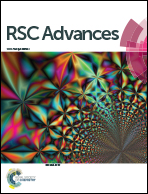A facile fabrication method for ultrathin NiO/Ni nanosheets as a high-performance electrocatalyst for the oxygen evolution reaction†
Abstract
In order to realize the oxygen evolution reaction (OER) with high efficiency on a large scale, a facile method has been created to fabricate NiO/Ni nanosheets by repeated size reduction and thermal oxidation on the surface. By using ultrathin Ni nanosheets with thicknesses of around 4 nm and different temperatures of thermal treatment, tunable oxidation of the metallic nanosheets was achieved. This was proven to have a great impact on the catalysts' electrical conductivity and activity. The NiO/Ni two-dimensional (2D) nano-metal catalyst prepared at 250 °C possesses a potential of 1.59 V (vs. RHE) at the current density of 100 mA cm−2 in 1 M KOH solution, and still exhibits a high performance after 15 000 cycles. Furthermore, the enhanced electrical conductivity and exposure of active sites contribute to a kinetically low-cost process, resulting in a Tafel slope of 51 mV dec−1. The repeated folding and calendering method is a mature industrial manufacturing procedure, and therefore this creative repeated size reduction and thermal oxidation production process for oxide/metal nanosheets has the potential to be extended to various kinds of metal materials that could be used to produce electrocatalysts in high yields.



 Please wait while we load your content...
Please wait while we load your content...